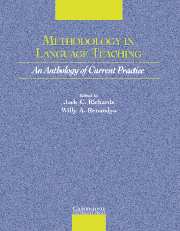Book contents
- Frontmatter
- Contents
- Acknowledgments
- Introduction
- Section I Approaches to Teaching
- Section 2 Lesson Planning and Classroom Management
- Section 3 Classroom Dynamics
- Section 4 Syllabus Design and Instructional Materials
- Section 5 Task and Project Work
- Section 6 Learning Strategies
- Section 7 Teaching Grammar
- Section 8 Teaching Pronunciation
- Section 9 Teaching Speaking
- Chapter 18 Factors to Consider: Developing Adult EFL Students' Speaking Abilities
- Chapter 19 Conversational English: An Interactive, Collaborative, and Reflective Approach
- Chapter 20 Developing Discussion Skills in the ESL Classroom
- Section 10 Teaching Listening
- Section 11 Teaching Vocabulary
- Section 12 Teaching Reading
- Section 13 Teaching Writing
- Section 14 Assessment
- Section 15 Technologies in the Classroom
- Section 16 Professional Development
- Credits
- Author Index
- Subject Index
- References
Chapter 19 - Conversational English: An Interactive, Collaborative, and Reflective Approach
Published online by Cambridge University Press: 10 November 2010
- Frontmatter
- Contents
- Acknowledgments
- Introduction
- Section I Approaches to Teaching
- Section 2 Lesson Planning and Classroom Management
- Section 3 Classroom Dynamics
- Section 4 Syllabus Design and Instructional Materials
- Section 5 Task and Project Work
- Section 6 Learning Strategies
- Section 7 Teaching Grammar
- Section 8 Teaching Pronunciation
- Section 9 Teaching Speaking
- Chapter 18 Factors to Consider: Developing Adult EFL Students' Speaking Abilities
- Chapter 19 Conversational English: An Interactive, Collaborative, and Reflective Approach
- Chapter 20 Developing Discussion Skills in the ESL Classroom
- Section 10 Teaching Listening
- Section 11 Teaching Vocabulary
- Section 12 Teaching Reading
- Section 13 Teaching Writing
- Section 14 Assessment
- Section 15 Technologies in the Classroom
- Section 16 Professional Development
- Credits
- Author Index
- Subject Index
- References
Summary
INTRODUCTION
Conversations are listener- or person-oriented (Brown & Yule, 1983; Slade, 1986). As in other speaking tasks, a conversation requires the speaker to ‘face temporal constraints and the social pressures of face-to-face interaction’ (Chafe, 1986, p. 16). A conversation is a truly communicative event which is ‘a dynamic exchange in which linguistic competence must adapt itself to the total informational input, both linguistic and paralinguistic’ (Savignon, 1971, cited in Higgs & Clifford, 1982, p. 58).
Conversations ‘begin with greetings and progress through various ordered moves: the speaker's and hearer's roles are ascertained, topics are introduced, rights to talk are assumed, new topics are raised, and at the appropriate time, the conversation is terminated in a suitable manner’ (Richards, 1983, p. 118). Put briefly, the speaker and the hearer have to take the initiative, ask questions, or express disagreement in the conversation, all of which require a command of particular language features and which ‘can be learnt’ (Underhill, 1987, p. 45). The conversation class reported here is based on this assumption of learnability.
In the researchers' opinion, traditional conversation classes in Hong Kong are characterised by the following features:
Input: There is a focus on formal aspects of language and a lack of attention to the processes of conversational interaction, including the collaborative aspects of conversational interaction, and the negotiation of conversational meanings and messages (Richards, 1985). Class input is typically provided by the teacher.
Error treatment and feedback: Errors are corrected by the teacher and the teacher alone during the practice, or forgotten entirely after it, with little attention to paralinguistics.
[…]
Information
- Type
- Chapter
- Information
- Methodology in Language TeachingAn Anthology of Current Practice, pp. 212 - 224Publisher: Cambridge University PressPrint publication year: 2002
References
Accessibility standard: Unknown
Why this information is here
This section outlines the accessibility features of this content - including support for screen readers, full keyboard navigation and high-contrast display options. This may not be relevant for you.Accessibility Information
- 2
- Cited by
